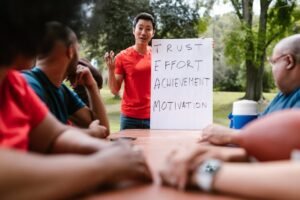Implementing the LeSS Framework: A Practical Guide
The Large Scale Scrum (LeSS) framework is becoming increasingly popular among organizations looking to scale agile practices across multiple teams. By offering a lightweight, adaptable approach, LeSS enables organizations to maintain the core principles of Scrum while coordinating efforts across larger groups. In this guide, we’ll explore how to effectively implement the LeSS framework in your organization, ensuring a seamless transition and maximizing the benefits of agile at scale.
Understanding the LeSS Framework
Before diving into implementation, it’s crucial to understand what LeSS is and how it differs from other scaling frameworks like SAFe or Nexus. LeSS is built on the principles of Scrum, emphasizing empirical process control, transparency, and collaboration. The framework is designed for organizations with multiple teams working on a single product, promoting a unified approach to product development.
Key Principles of LeSS
There are several key principles that underpin the LeSS framework:
- Customer-Centricity: LeSS focuses on delivering value to the customer by prioritizing features that provide the greatest benefit.
- Empirical Process: LeSS encourages regular experimentation and inspection to improve processes continuously.
- Whole Product Focus: Teams work collaboratively on a single product, ensuring alignment and coherence.
Steps to Implement the LeSS Framework
Implementing LeSS requires careful planning and a commitment to change. Here, we’ll outline the steps necessary to successfully adopt the framework.
1. Assess Organizational Readiness
Before implementing LeSS, assess your organization’s readiness for change. This includes evaluating current processes, team structures, and leadership support. Organizations that have successfully adopted LeSS often report an increase in productivity by up to 25% and improved product quality.
2. Train Your Teams
Education is a critical component of any agile transformation. Ensure that all team members, including leadership, receive training on the LeSS framework. Consider hiring a certified LeSS trainer or coach to facilitate this process.
3. Establish a Common Product Backlog
A single, prioritized product backlog is essential for aligning multiple teams. This backlog should be managed by a Product Owner who understands the business goals and customer needs. The Product Owner’s role is to ensure that the backlog reflects the most valuable work for the organization.
4. Form Cross-Functional Teams
LeSS emphasizes the importance of cross-functional teams that can deliver end-to-end value without dependencies on other teams. Aim to create teams with a diverse set of skills, including development, testing, and design capabilities.
5. Conduct Sprint Planning and Reviews
Regular sprint planning and reviews are crucial for maintaining alignment and transparency. During sprint planning, teams select items from the product backlog to work on, while reviews provide an opportunity to demonstrate progress and gather feedback.
6. Implement Continuous Improvement Practices
Continuous improvement is at the heart of LeSS. Encourage teams to hold retrospectives to identify areas for improvement and experiment with new practices. A study by McKinsey found that organizations embracing continuous improvement see a 20% increase in efficiency.
Overcoming Challenges in LeSS Implementation
While the benefits of LeSS are significant, organizations may encounter challenges during implementation. Here are some common obstacles and strategies to address them.
Resistance to Change
Change can be difficult, and some team members may resist transitioning to a new framework. To overcome this, communicate the benefits of LeSS clearly and engage employees in the change process. Encourage open dialogue and provide support through training and coaching.
Maintaining Consistent Communication
With multiple teams working on a single product, maintaining clear and consistent communication is vital. Implement regular synchronization meetings and use collaboration tools like Slack or Microsoft Teams to facilitate ongoing communication.
Ensuring Leadership Support
Leadership support is critical for the success of any agile transformation. Leaders should be actively involved in the process, providing guidance and removing obstacles. A CIO survey revealed that companies with strong leadership support for agile transformations are 30% more likely to succeed.
Conclusion
Implementing the LeSS framework can transform how your organization delivers value, fostering a more collaborative and efficient environment. By understanding the principles of LeSS and following the steps outlined in this guide, you can successfully scale agile practices across multiple teams. Remember to address potential challenges proactively and maintain a focus on continuous improvement. With the right approach, the LeSS framework can lead to substantial improvements in productivity and customer satisfaction.
For more detailed information on LeSS and to access additional resources, visit the official LeSS website at less.works.













